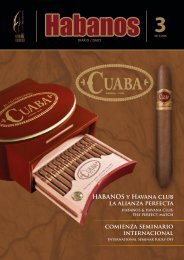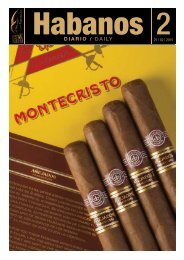You also want an ePaper? Increase the reach of your titles
YUMPU automatically turns print PDFs into web optimized ePapers that Google loves.
COHIBA<br />
XVIII FESTIVAL HABANO<br />
La historia de una marca<br />
A Story Full of Intimacies and Secrets<br />
Una de las características esenciales de la marca es utilizar el mejor tabaco cosechado en Vegas de Primera,<br />
seleccionadas en Vuelta Abajo, Pinar del Río<br />
One of the brand’s key features is the use of the finest tobacco harvested in top-of-the-line plantations from Vuelta Abajo, Pinar del Rio<br />
La historia de las diferentes ediciones de la más emblemática<br />
marca de <strong>Habanos</strong>, S.A. comenzó mucho<br />
antes de que fueran bautizados por la heroína cubana<br />
Celia Sánchez Manduley, retomando el término con el<br />
cual los aborígenes cubanos llamaban al rústico rollo que<br />
preparaban con las hojas de tabaco para luego fumarlas.<br />
Originarios de una fuma, como le denominan los torcedores<br />
a los puros que hacen para su propio consumo, fueron<br />
los Lanceros los primeros que comenzaron a obsequiarse<br />
como presente personal del presidente cubano, Fidel Castro<br />
Ruz, a dignatarios y visitantes extranjeros. Por entonces ni<br />
siquiera tenían un nombre o marca distintiva y las anillas<br />
ostentaban los nombres de las personalidades a las cuales<br />
estaba destinado el preciado regalo.<br />
Cuando comenzaron a producirse en serie en 1966, ya<br />
bautizados como Cohiba, demoraron todavía en tener su propio<br />
diseño, el cual se dio a conocer en 1969, y que exhibía entonces<br />
una especie de vitral en una mitad de semicírculo, debajo del<br />
cual, sobre fondo negro, se destacaba la palabra “Cohiba”, todo<br />
encerrado en una anilla dividida en colores blanco y negro.<br />
Poco después la anilla sería cambiada, pasando a tener<br />
el nombre de la marca en medio de una anilla mitad color<br />
amarillo dorado, y encima una especie de tablero de ajedrez.<br />
En este mismo diseño se utilizó por primera vez en las etiquetas<br />
y cajas la figura de una cabeza de indio taíno, que<br />
todavía con variadas modificaciones se mantiene hoy.<br />
Una de las características esenciales de la marca Cohiba<br />
es utilizar el mejor tabaco cosechado en vegas de Primera<br />
seleccionadas en Vuelta Abajo (Pinar del Río), particularmente<br />
de la vega El Corojo, que produce una capa suave de<br />
textura fina y colores claros. Para su tripa se usan las mejores<br />
hojas de las vegas finas de sol de Pinar del Río, de San Luis y<br />
de San Juan, en Vuelta Abajo.<br />
Otro elemento distintivo de Cohiba es la denominada<br />
“fermentación adicional”, un proceso especial con una leve<br />
fermentación junto con un añejamiento.<br />
Gracias a una constante innovación, Cohiba ha sido<br />
siempre la marca de vanguardia que lidera todas las<br />
tendencias en el mundo del Habano, siendo la primera<br />
que introdujo una Reserva en el año 2002, y una Gran<br />
Reserva en el año 2009<br />
Anilla de Cohiba, primer diseño de 1969<br />
Segundo diseño de la etiqueta Cohiba. 1969 a 1989.<br />
Diseño actual de la etiqueta Cohiba.<br />
The history of the different editions from <strong>Habanos</strong><br />
S.A.’s flagship brand –the Cohiba habanos- teed<br />
off long before they were named by Cuban<br />
heroine Celia Sanchez Manduley, who dusted off the<br />
old term used by Cuban aboriginals to call their rustic<br />
roll of tobacco leaves they used to smoke.<br />
Stemming right from the smokes cigar rollers<br />
prepare for themselves, Lanceros were the first<br />
habanos Cuban President Fidel Castro used to give as a<br />
personal gift to dignitaries and foreign visitors. At that<br />
time, they didn’t have a name or distinctive brand to<br />
call their own, and the band showed the name of the<br />
personality the precious gift was destined to.<br />
Mass production began revving up in 1966 –finally<br />
named as Cohiba- and yet they didn’t have a design<br />
of their own, which was eventually revealed in 1969.<br />
It was some kind of black-and-white stained-glass<br />
window inside half a semicircle, sporting the word<br />
“Cohiba” under it on a black backdrop. All that much was<br />
clustered into a band that was half white and half black.<br />
Shortly after that, the band was transformed,<br />
with the brand name in the middle of a band that was<br />
half gilt and showed some sort of chessboard on top.<br />
In that same design, the head of a Taino aboriginal<br />
was used for the first time, an icon that has lived out to<br />
date amid a number of modifications.<br />
One of the main features of the Cohiba brand<br />
is the use of the best tobacco harvested in the fine<br />
plantations of Vuelta Abajo (Pinar del Rio), especially<br />
the one hailing from El Corojo, which produces a softtexture<br />
and light-colored wrapper leaf. For the filler,<br />
Cohiba takes the very best sun-grown leaves out of<br />
Pinar del Río, from San Luis y San Juan in Vuelta Abajo.<br />
Another characteristic of the Cohiba brand is the socalled<br />
“third fermentation”, a special process consisting<br />
of slight fermenting coupled with an aging procedure.<br />
Thanks to nonstop innovation, Cohiba has<br />
always been the leading brand that marches ahead<br />
of all trendsetters in the realm of habanos. It was the<br />
first to introduce a Reserve back in 2002, and a Grand<br />
Reserve in 2009





